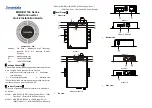
6A
Configuration
Select Battery Type—REQUIRED
CAUTION:
The Battery Type DIP Switch setting must match
the type of batteries you connect, or your batteries may be
degraded or damaged over an extended period of time. See
“Battery Selection,” p. 7 for more information.
Battery Type
Switch Position
Gel Cell (Sealed) Battery
Up
Wet Cell (Vented) Battery
Down (factory setting)
Select High AC Input Voltage Point
for Switching to Battery—OPTIONAL*
Voltage
Switch Position
278V Up
259V
Down (factory setting)
Set Configuration DIP Switches
Using a small tool, set the Configuration DIP Switches (located on the front panel of your unit, see diagram) to optimize Inverter/Charger
operation depending on your application.
A1
A2
A3
A4
INPUT C/B 10A
OUTPUT C/B 12A
A4
A3
A2
A1
Dip Switches
DIP Switches
Select Low AC Input Voltage Point for Switching to
Battery—OPTIONAL*
Voltage
Switch Position
201V
#A4 Up & #A3 Up
182V
#A4 Up & #A3 Down
163V
#A4 Down & #A3 Up
144V
#A4 Down & #A3 Down (factory setting)
* Most of your connected appliances and equipment will perform adequately when your Inverter/Charger’s High AC Input Voltage Point is left in the factory setting and its Low AC Voltage Input
Point is set to 182V. However, if the unit frequently switches to battery power due to momentary high/low line voltage swings that would have little effect on equipment operation, you may wish to
adjust these settings. By increasing the High AC Voltage Point and/or decreasing the Low AC Voltage Point, you will reduce the number of times your unit switches to battery due to voltage swings.
Connect Remote Control—Optional
All models feature an 8-conductor telephone style receptacle on the front panel for use with an optional remote control module (Tripp Lite
model APSRM2, sold separately). The remote module allows the Inverter/Charger to be mounted in a compartment or cabinet out of sight, while
operated conveniently from a remote location. See instructions packed with the remote control module.
A1
A2
A3
A4






























